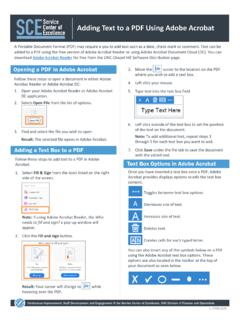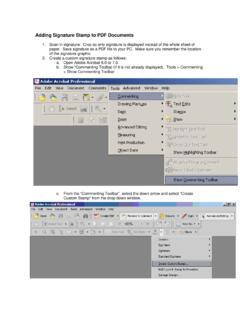Transcription of arXiv:1507.05717v1 [cs.CV] 21 Jul 2015
1 An End-to-End Trainable Neural Network for Image-based SequenceRecognition and Its Application to Scene Text RecognitionBaoguang Shi, Xiang Bai and Cong YaoSchool of Electronic Information and CommunicationsHuazhong University of Science and Technology, Wuhan, sequence recognition has been a long-standing research topic in computer vision. In this pa-per, we investigate the problem of scene text recognition,which is among the most important and challenging tasksin image-based sequence recognition. A novel neural net-work architecture, which integrates feature extraction, se-quence modeling and transcription into a unified frame-work, is proposed.
2 Compared with previous systems forscene text recognition, the proposed architecture possessesfour distinctive properties: (1) It is end-to-end trainable,in contrast to most of the existing algorithms whose compo-nents are separately trained and tuned. (2) It naturally han-dles sequences in arbitrary lengths, involving no charactersegmentation or horizontal scale normalization. (3) It is notconfined to any predefined lexicon and achieves remarkableperformances in both lexicon-free and lexicon-based scenetext recognition tasks. (4) It generates an effective yet muchsmaller model, which is more practical for real-world ap-plication scenarios.
3 The experiments on standard bench-marks, including the IIIT-5K, Street View Text and ICDAR datasets, demonstrate the superiority of the proposed algo-rithm over the prior arts. Moreover, the proposed algorithmperforms well in the task of image-based music score recog-nition, which evidently verifies the generality of IntroductionRecently, the community has seen a strong revival ofneural networks, which is mainly stimulated by the greatsuccess of deep neural network models, specifically DeepConvolutional Neural Networks (DCNN), in various visiontasks. However, majority of the recent works related to deepneural networks have devoted to detection or classificationof object categories [12, 25].
4 In this paper, we are con-cerned with a classic problem in computer vision: image-based sequence recognition. In real world, a stable of vi-sual objects, such as scene text, handwriting and musicalscore, tend to occur in the form of sequence, not in isola-tion. Unlike general object recognition, recognizing suchsequence-like objects often requires the system to predicta series of object labels, instead of a single label. There-fore, recognition of such objects can be naturally cast as asequence recognition problem. Another unique property ofsequence-like objects is that their lengths may vary drasti-cally. For instance, English words can either consist of 2characters such as OK or 15 characters such as congrat-ulations.
5 Consequently, the most popular deep models likeDCNN [25, 26] cannot be directly applied to sequence pre-diction, since DCNN models often operate on inputs andoutputs with fixed dimensions, and thus are incapable ofproducing a variable-length label attempts have been made to address this problemfor a specific sequence-like object ( text). Forexample, the algorithms in [35, 8] firstly detect individualcharacters and then recognize these detected characters withDCNN models, which are trained using labeled characterimages. Such methods often require training a strong char-acter detector for accurately detecting and cropping eachcharacter out from the original word image.
6 Some otherapproaches (such as [22]) treat scene text recognition asan image classification problem, and assign a class labelto each English word (90K words in total). It turns out alarge trained model with a huge number of classes, whichis difficult to be generalized to other types of sequence-like objects, such as Chinese texts , musical scores,etc., be-cause the numbers of basic combinations of such kind ofsequences can be greater than 1 million. In summary, cur-rent systems based on DCNN can not be directly used forimage-based sequence neural networks (RNN) models, another im-portant branch of the deep neural networks family, weremainly designed for handling sequences.
7 One of the ad-vantages of RNN is that it does not need the position ofeach element in a sequence object image in both trainingand testing. However, a preprocessing step that converts1 [ ] 21 Jul 2015an input object image into a sequence of image features, isusually essential. For example, Graveset al.[16] extract aset of geometrical or image features from handwritten texts ,while Su and Lu [33] convert word images into sequentialHOG features. The preprocessing step is independent ofthe subsequent components in the pipeline, thus the existingsystems based on RNN can not be trained and optimized inan end-to-end conventional scene text recognition methods thatare not based on neural networks also brought insightfulideas and novel representations into this field.
8 For example,Almaz`anet al.[5] and Rodriguez-Serranoet al.[30] pro-posed to embed word images and text strings in a commonvectorial subspace, and word recognition is converted intoa retrieval problem. Yaoet al.[36] and Gordoet al.[14]used mid-level features for scene text recognition. Thoughachieved promising performance on standard benchmarks,these methods are generally outperformed by previous al-gorithms based on neural networks [8, 22], as well as theapproach proposed in this main contribution of this paper is a novel neuralnetwork model, whose network architecture is specificallydesigned for recognizing sequence-like objects in proposed neural network model is named as Convo-lutional Recurrent Neural Network (CRNN), since it is acombination of DCNN and RNN.
9 For sequence-like ob-jects, CRNN possesses several distinctive advantages overconventional neural network models: 1) It can be directlylearned from sequence labels (for instance, words), requir-ing no detailed annotations (for instance, characters); 2) Ithas the same property of DCNN on learning informativerepresentations directly from image data, requiring neitherhand-craft features nor preprocessing steps, including bi-narization/segmentation, component localization,etc.; 3) Ithas the same property of RNN, being able to produce a se-quence of labels; 4) It is unconstrained to the lengths ofsequence-like objects, requiring only height normalizationin both training and testing phases; 5) It achieves better orhighly competitive performance on scene texts (word recog-nition) than the prior arts [23, 8]; 6) It contains much lessparameters than a standard DCNN model, consuming lessstorage The Proposed Network ArchitectureThe network architecture of CRNN, as shown in Fig.
10 1,consists of three components, including the convolutionallayers, the recurrent layers, and a transcription layer, frombottom to the bottom of CRNN, the convolutional layers auto-matically extract a feature sequence from each input top of the convolutional network, a recurrent networkis built for making prediction for each frame of the featuresequence, outputted by the convolutional layers. The tran-scription layer at the top of CRNN is adopted to translate theper-frame predictions by the recurrent layers into a label se-quence. Though CRNN is composed of different kinds ofnetwork architectures (eg. CNN and RNN), it can be jointlytrained with one loss "state"TranscriptionLayerInput imageConvolutionalfeature mapsConvolutionalfeature mapsFeaturesequenceDeepbidirectionalLSTM Per-framepredictions(disbritutions) 1.
![arXiv:0706.3639v1 [cs.AI] 25 Jun 2007](/cache/preview/4/1/3/9/3/1/4/b/thumb-4139314b93ef86b7b4c2d05ebcc88e46.jpg)

![arXiv:1301.3781v3 [cs.CL] 7 Sep 2013](/cache/preview/4/d/5/0/4/3/4/0/thumb-4d504340120163c0bdf3f4678d8d217f.jpg)
![@google.com arXiv:1609.03499v2 [cs.SD] 19 Sep 2016](/cache/preview/c/3/4/9/4/6/9/b/thumb-c349469b499107d21e221f2ac908f8b2.jpg)












